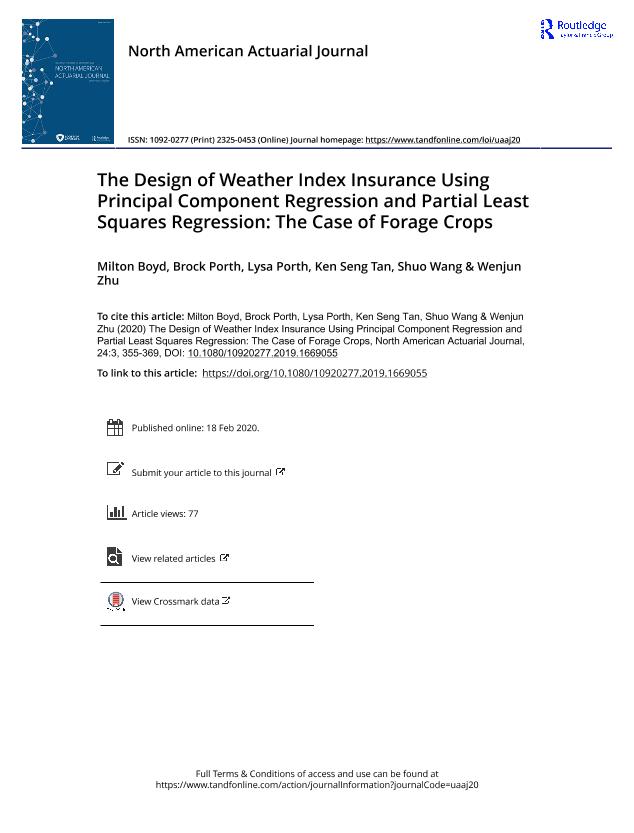The Design of weather index insurance using principal component regression and partial least squares regression : the case of forage crops

Contenido multimedia no disponible por derechos de autor o por acceso restringido. Contacte con la institución para más información.
| Tag | 1 | 2 | Valor |
|---|---|---|---|
| LDR | 00000cab a2200000 4500 | ||
| 001 | MAP20200031529 | ||
| 003 | MAP | ||
| 005 | 20201006140747.0 | ||
| 008 | 201006e20200901usa|||p |0|||b|eng d | ||
| 040 | $aMAP$bspa$dMAP | ||
| 084 | $a6 | ||
| 245 | 1 | 4 | $aThe Design of weather index insurance using principal component regression and partial least squares regression$b: the case of forage crops$cMilton Boyd...[Et al.] |
| 520 | $aWeather index insurance is a relatively new alternative to traditional agricultural insurance such as individual yield-based crop insurance. It is still mostly at the experimental stage, rather than in widespread use like traditional crop insurance. A major challenge for weather insurance is basis risk, where the loss estimated by the index differs from the actual loss, and this is generally believed to be the main limitation in the use of weather index insurance for crops. Variable basis risk is an important type of basis risk that occurs when there are incorrect variables or missing variables for the design of the weather index. In agriculture, there is a relatively small sample size of yields, and therefore, as the number of considered weather variables increases, the problems of limited degrees of freedom for predictive models must be overcome. The objective of this article is to demonstrate two possible approaches that could be used to construct a multivariable weather index to reduce variable basis risk. Forage insurance is used as an example, and a main focus of the research is on reducing the dimensionality of the predictive model and resolving the problem of multicollinearity among weather variables. The research uses daily weather information and county-level forage yield data from Ontario, Canada. Two multivariable indices are developed based on principal component regression (PCR) and partial least squares regression (PLSR) methods, and they are evaluated against a single-variable benchmark index based on cumulative precipitation (SVCP) using several basis risk metrics. The results show that both the PCR and PLSR models are superior compared to the single-variable weather index based on cumulative rainfall (SVCR) index and can be used to achieve the objective of reducing the dimensionality of the weather variable matrix and addressing the issue of multicollinearity. Though the PLSR indices perform better than the PCR and SVCR indices in terms of average value of basis risk E(BRÞ),(rom) the PCR method produces a smaller percentage of mismatch, suggesting that the PCR method may be superior in correctly detecting when the insurance payment should be triggered. The methods demonstrated in this article will assist in the development of weather indexbased crop insurance. | ||
| 650 | 4 | $0MAPA20080586294$aMercado de seguros | |
| 650 | 4 | $0MAPA20080578213$aSeguros agrarios | |
| 650 | 4 | $0MAPA20080592059$aModelos predictivos | |
| 650 | 4 | $0MAPA20080587857$aSeguro de cosechas | |
| 650 | 4 | $0MAPA20080602437$aMatemática del seguro | |
| 700 | 1 | $0MAPA20200000068$aBoyd, Milton | |
| 773 | 0 | $wMAP20077000239$tNorth American actuarial journal$dSchaumburg : Society of Actuaries, 1997-$x1092-0277$g01/09/2020 Tomo 24 Número 3 - 2020 , p. 355-369 |

